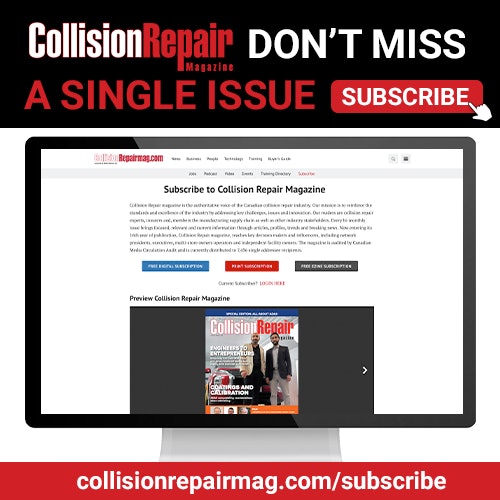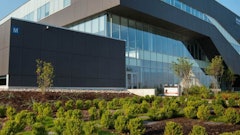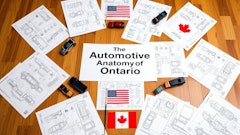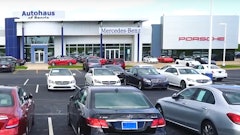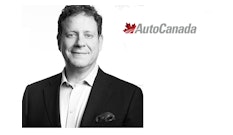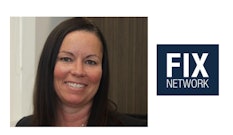
David Roberts, the founder and managing director of Focus Advisors Automotive M&A, presented the collision repair
industry’s market update at last year’s MSO Symposium in early November in Las Vegas. Roberts addressed an audience of more than 400 attendees in his presentation titled “Scale and its Rewards: Industry Landscape and Market Dynamics”. He set the tone from the start, stating, “to succeed in an industry where complexity and access to repairable vehicles are ever more challenging, operators with scale will continue to grow and thrive.”
KEY TRENDS IN THE COLLISION REPAIR INDUSTRY
The industry seems to be normalizing more towards pre-COVID conditions. Meanwhile, vehicles have grown in complexity. Scale and specialization play pivotal roles for the operators that want to compete.
• Revenue Changes: The collision repair industry had softened revenues throughout 2024. Revenues are flat or down for many, and up only for a few exceptions. Single shops have seen their revenues decline most dramatically. WIP is down across the board, returning to more normal levels after the exceptional post-COVID period. In a similar trend, labor rate increases are returning to normal, and there are just fewer repairable vehicles, prompting shops to focus more on getting the work. While WIP and labor rate increases are normalizing, the average total cost of repair is still up 3.7 percent year-overyear, now exceeding US$4,600.
• Shop Numbers: Revenue slowdown and industry consolidation had resulted in a decline in single shops. Focus Advisors anticipates there were nearly 800 closures of smaller, independent shops this year. Medium and large MSOs, meanwhile, are better poised to grow; Roberts said, “Independent MSOs with four to six shops—and especially those with seven or more—are not just surviving; they’re thriving,” The consolidators and larger independent MSOs are able to grow their market share by focusing on advanced repair technologies and operational efficiencies, which most often come from scale.
THE CONSOLIDATION LANDSCAPE
In his MSO presentation in 2023, Roberts introduced the “Fish Scale” that classifies the collision repairers in terms of their size. The “Whales” consist of the “Big Five” consolidators: Caliber, Crash Champions, Gerber, Classic Collision, and Joe Hudson’s. In 2024, their cumulative market share comprises 30 percent. Their collective footprint grew 13 percent, from 3,512 shops to 3,842 in 2024. Caliber Collision stands apart within the “Whales”, with more than 1,800 shops and growing every day.
Two other “Whales”, Classic Collision and Joe Hudson’s, each grew their shop counts by north of 22 percent in 2024, almost exclusively through the acquisitions of single shops or MSOs. This growth is almost three times that of Caliber, Gerber and Crash Champions.
A more remarkable trend of 2024 has been the breakneck expansion of the “Sharks” cohort that Roberts introduced in 2023 as the seven fully—or newly launched MSOs with private equity sponsors. These seven are: Quality Collision Group, CollisionRight, Kaizen Collision, VIVE Collision, OpenRoad Collision, Puget Collision, and BrightPoint Auto Body. Collectively, they have almost three percent of the total market share across 376 shops. They’ve collectively added close to 100 shops this year, mostly through acquisitions. The benefits of scale are seen northward in Canada. Some of the largest independent MSOs in Canada are the private equity-backed Lift Auto Group, Craftsman Collision and Kirmac Collision, all concentrated in British Columbia. Meanwhile, the Fix Auto franchise has expanded with new franchise partners such as Fix Auto Halifax in Nova Scotia and Fix Auto North York in Ontario.
CSN Collision Centers has been investing in training, equipment, and OEM certifications to support its growth and high standards. ProColor Collision has been actively expanding its presence in Canada in 2024. As of the end of the year, they have over 170 locations throughout Canada. In September 2024, the network launched a new location in Niagara Falls, Ontario led by industry veteran Justin Haars.
The CARSTAR franchise has grown its footprint in Canada, with approximately 320 locations. Another franchise, Simplicity Car Care, has grown from 60 locations in 2021 to 101 at the time of Roberts’s presentation, their geography focused mostly on Ontario and Quebec.
While the industry has consolidated a great deal in Canada and the average severity remains high, the major headwind that the Canadian collision industry faces is the technician shortage. According to the Romans Report, the latest data indicates the industry is still short by 30 percent to 40 percent of the number of technicians needed. While there have been efforts to implement a national auto body accreditation program that will generate more capable techs, this is still in development, aggravating the technician shortage. This will grow more significant as Canada makes way on its effort for 100 percent zero-emission car sales by 2035, as EVs require highly skilled techs.

INDEPENDENT MSOS: A GROWING FORCE
Independent MSOs with seven or more shops now number 48, up from 43 last year. If one were to count all independent MSOs that are neither “Whales” nor “Sharks”, there are nearly 800. Collectively, they generate over US$8 billion in revenue, matching the total revenues of Caliber Collision. Roberts emphasized the entrepreneurial vision driving their success, stating, “It really comes down to the vision of the entrepreneurs and the opportunities they see in their markets.”
Each of the independent MSOs has its unique “playbook” of how it’s able to compete in its market. To name a few playbooks, some focus on OEM certifications, others on EVs or fleet work, while others either acquire distressed single-shops and turn them around, or alternatively, build their own shops from the ground up.
PRIVATE EQUITY’S PLAYBOOK
The collision repair industry remains highly attractive to private equity investors due to its strong existing returns and the tailwinds PE firms see in the collision industry. Roberts said that Focus Advisors had received inbound interest from over 50 PE firms in 2024 interested in the space. PE-backed consolidators are using acquisition strategies and operational improvements to achieve the end-goal of significant EBITDA growth and higher EBITDA multiples.
• PE’s Perspective: Roberts walked the audience through a typical PE strategy playbook to illustrate why there’s been so much interest.
i. Initial Acquisition: PE firm buys a collision repair platform for $48M, with $6M EBITDA at 8x multiple.
ii. Add-On Strategy: Plans to acquire 30 smaller shops, each with $500K EBITDA, for $75M total at 5x multiple.
iii. Total Investment: Combined investment reaches $123M.
iv. Growth Targets: Aims for 20 percent revenue growth and two percent EBITDA margin improvement over five years, targeting $30M EBITDA.
v. Re-Capitalization: Plans to re-capitalize at 10x EBITDA, valuing the business at $300M.
vi. Financial Gain: Expects $177M absolute gain (143 percent return).
vii. Leverage Impact: Return on equity amplified by typical three-to-one debt leverage ratio.
Roberts emphasized that this playbook is what has driven PE to continue to try to enter this space. While the financial structure is compelling, he also articulated some of the risks of this industry, citing: acquisitions cost more than expected; key management leaves; increases in labor costs and parts costs push down margins; industry revenues slow down and insurance companies apply downward pressures on margins.



Through specific case studies as well as the statistics on the bigger-picture of independent MSOs, it became clear that there are still many paths for the independent MSOs to compete against the national consolidators or PE-backed “Sharks”. By focusing on a specialized strategic playbook and their economies of scale, these independents can grow their market share and EBITDA margin.
And with the increased interest by existing buyers and PE firms hoping to enter the industry, that higher EBITDA commands a higher EBITDA multiple—whether an owner of an independent MSO seeks growth capital or an exit.
Roberts concluded his presentation by providing some predictions for the collision repair industry. In the near-term, he foresees:
• Insurance companies will raise rates, deductibles, and squeeze collision repair providers.
• Vehicles will grow in complexity.
• OEMs will raise certification standards, training, equipment requirements, and they will limit access to parts.
• Consolidators will invest more in highly certified repair facilitators.
• Competition for highly trained technicians will become more fierce.
And over the next decade or so, he anticipates:
• There will continue to be conflict between OEMs and insurers, with more power going to dealers and OEMs.
• That will encourage MSOs to focus more on certifications and closer associations with dealerships.
• 1,000 or more shops will exit each year over the next five years.
• The retrenchment of electric vehicles is temporary and EVs will come back.
• Self-driving vehicles will proliferate in urban areas. They could disrupt repair volumes due to lower collision rates.
• The best repairers will become super-efficient while simultaneously becoming super capable.
• OEMs will increase their commitment to their own captive insurance companies.
• Consolidators will achieve more than 50 percent market share.
• Large regional MSOs will increase as more capital and more M&A will enable growth.
• There will be increased responsibility for settling claims at the MSO- and consolidator- level.
Roberts concluded with a reflection on the opportunities for collision repairers at scale: “The best repairers will need to be super-efficient. Consolidators and independent regional MSOs with a focus on the most advanced skill sets and certifications will dominate.”

Focus Advisors (www.focusadvisors.com) is the collision industry’s leading M&A advisory firm, partnering with independent MSOs between $10-100M in annual revenue, helping owners achieve maximum value through strategic growth and exits. Unlike traditional business brokers or large investment banks, Focus Advisors specializes exclusively in collision repair — giving owners unparalleled insight into value, interest, and opportunity timing. With over 25 years in the industry, Managing Director David Roberts has led more than 40 transactions totaling over $500 million in transaction value and more than 325 collision repair shops, including Tripp’s Collision, Pride Auto Body, Painter’s Collision, Mills Body Shops, and Master Collision.

